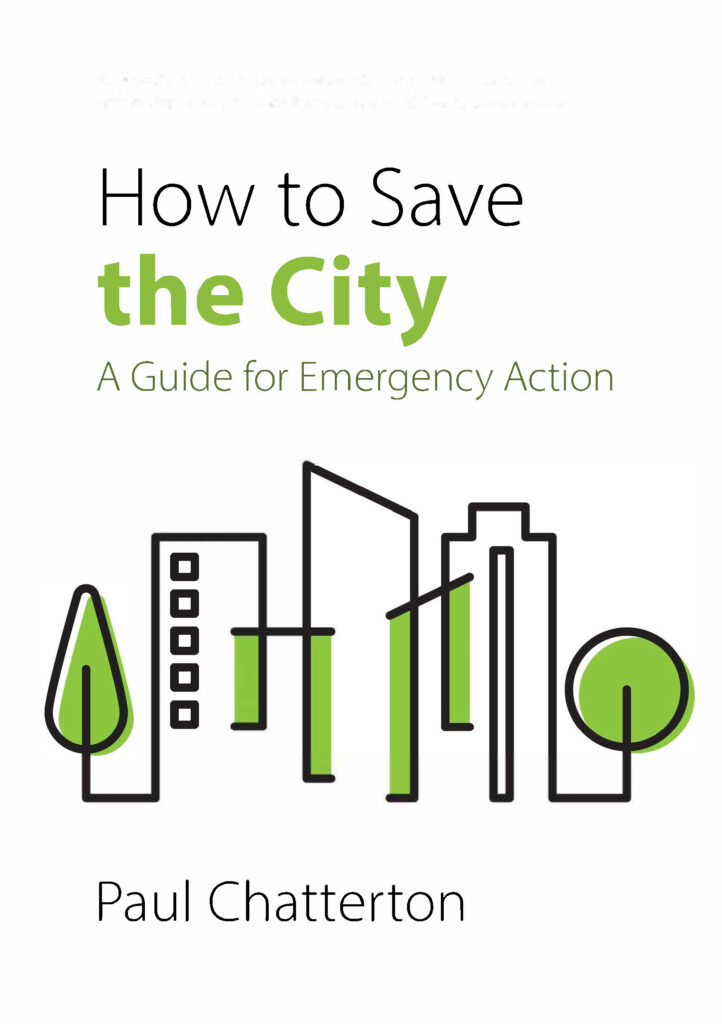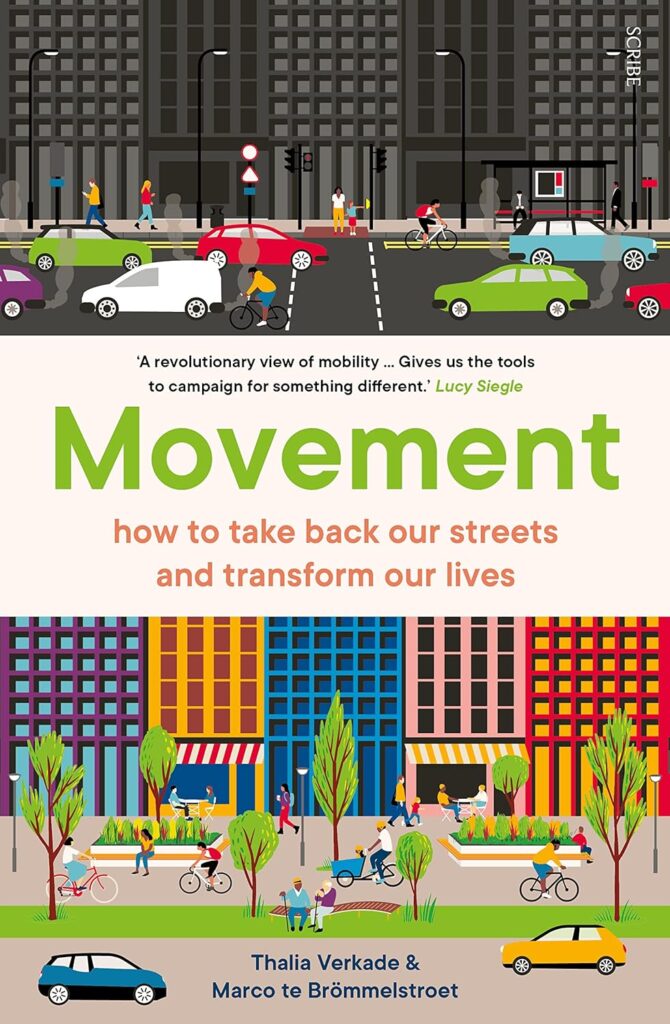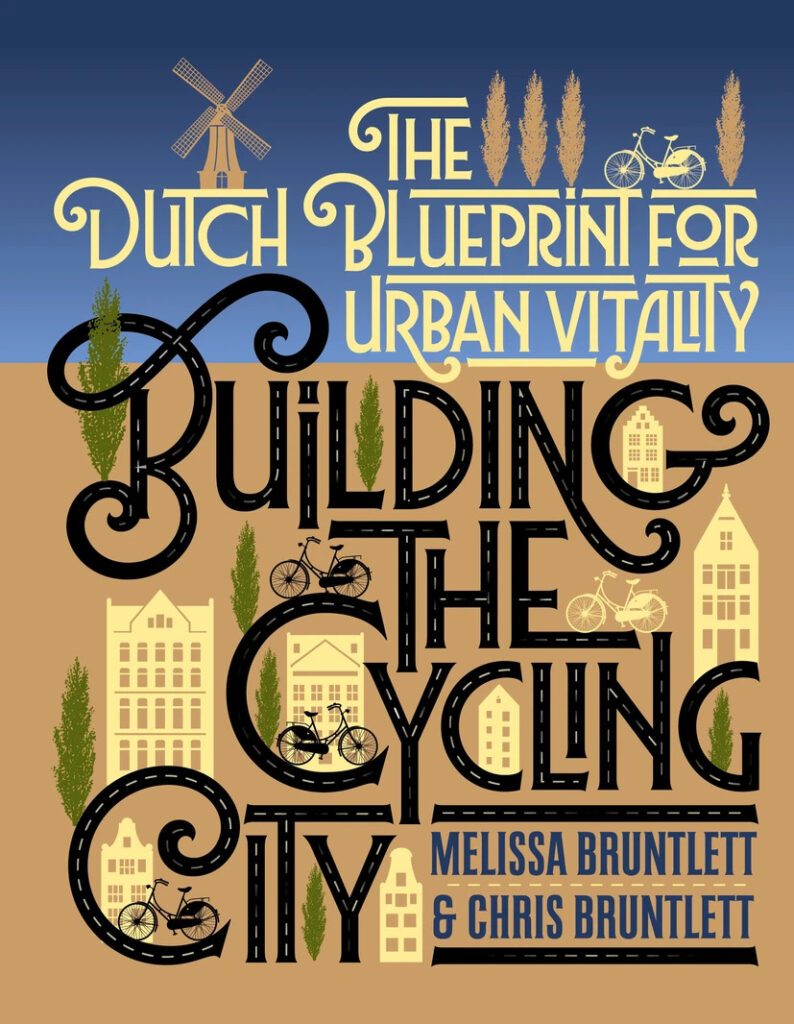
Copenhagenize: The Definitive Guide to Bicycle Urbanism, by Mikael Colville-Andersen. Island Press, 296 pp, March 2018, ISBN 9781610919388
Building the Cycling City: The Dutch Blueprint for Urban Vitality, by Melissa and Chris Bruntlett. Island Press, 240 pp, August 2018, ISBN 9781610918794
What is it about?
Mikael Colville-Andersen’s Copenhagenize – following the name of his well-known blog and cycling consulting company – is a nicely published book, which will be received with applause by those who agree with him. It is also an immodest book which makes immodest claims: namely, that “the bicycle is the single most important tool in our urban toolbox for improving our cities”(p. 1), and a little further on, that “[the bicycle] is the most perfect vehicle for urban living ever invented” (p. 35).
The personal story of Colville-Andersen is an interesting one. According to him, his messianic epiphany in relation to cycling resulted from suffering a serious traffic accident (followed by a miraculous survival), which led to a life-long hatred of cars. Being a filmmaker and photographer, in 2006 he started posting photographs of everyday cyclists in Copenhagen dressed in casually elegant clothes on his blog, using the label “Cycle Chic”. In doing so, he unwittingly spurred a global trend which eventually led to the existence of more than 200 copycat “Cycle Chic” blogs in cities all over the world. Seizing the momentum of the moment, Colville-Andersen decided to make the most of it and, assisted by his considerable flair for marketing and branding, gradually transformed himself into the world’s most prominent urban cycling guru. His is a story of being the right man at the right time and the right place.
Above all, Copenhagenize constitutes an important attempt to build on the still young field of “bicycle urbanism”. It is largely based on commonsensical observations from real life, revealing an indebtedness to Jane Jacobs and following closely in the footsteps of Jan Gehl. The book main’s and strongest argument is that cycling needs to be understood not as something special, but simply as a normal practice embedded in everyday life, much like using a vacuum cleaner. Following this logic, a good cycle network should be like a well-designed chair, functional and perhaps even elegant, but not drawing too much attention to itself.
The most interesting parts come from the author’s own personal observations of small, apparently insignificant details of a mature cycling culture, which nevertheless amount to something significant when considered together. A good example of this is what he calls a “bicycle magnet”: the process by which a single bicycle parked on the sidewalk immediately leads other people to park their own bike next to it, both out of imitation and out of a semiconscious effort to make their bicycle less conspicuous to potential thieves. Colville-Andersen clearly also has a lot of experience of seeing and thinking about cycling infrastructure. This leads him to intuitively come up with reasonable conclusions: any seasoned cyclist will feel that he is right, for instance, in pointing out that building bike lanes along the road median is always a mistake.
What approach does it take?
The book’s smart alec tone might irritate some potential readers, but it also makes for some provocative points, such as the suggestion that motor vehicles should carry a health warning sticker on them. Along the way, there are also some interesting side reflections comparing Dutch and Danish cycling cultures. While Colville-Andersen concedes that the Dutch ultimately have a stronger cycling culture and cycle more, he also notes that foreign delegations find it much easier to imagine importing the Copenhagen model to their home contexts, because it is feels more relatable than the idiosyncratic urban landscape of the Netherlands.
At the same time, one could also say that Copenhagenize does not really teach us anything new. Of course, this is also kind of the point: Colville-Anderson’s stated aim is to “simplify a subject that has been needlessly overcomplicated” (p. 274), and to do so in a manner which is “unencumbered by academic indoctrination” (p. 7). For the most part, this approach seems to pay off. We can almost reduce the book’s main points to two recommendations: plan routes that allow cyclists to travel directly from A to B, and segregate them from motorised traffic above a certain speed. Although Colville-Andersen acknowledges the existence of certain limits to copy-pasting cycling infrastructure between cities, he also makes a persuasive case that, for the most part, such an approach works pretty well.
Of course, this simple approach also makes it a relatively unnuanced one. In particular, Colville-Andersen seems to relish casting traffic engineers as the bad guys who stole our cities from us for the latter half of last century. If the negative consequences of car use and the benefits of cycling are so overwhelmingly evident, how come we let ourselves be “abducted” so easily ? The book provides some coverage of the emotional force of the ideal of automobility, but it only pays little attention to how it became so dominant and how it might realistically be broken up. In this respect, Colville-Andersen identifies political leadership with a will to get things done as the single most important factor in improving conditions for cycling. He is undoubtedly right, but it also makes it hard to see what to do in contexts where such a political leadership is missing. Being based in Copenhagen, he seems to take the existence of an enlightened municipality with a strong capacity of action largely for granted.
On first impression, Melissa and Chris Bruntlett’s Building the Cycling City seems to provide a natural companion to Copenhagenize. While its subtitle reads The Dutch Blueprint for Urban Vitality, it turns out that, unlike Copenhagenize, it is really not much of a blueprint at all. The closest it comes to this is in the introduction, which suggests that the recipe for cycling largely boils down to providing dense cycling infrastructure, taking measures to tame motor vehicles, and waiting for time to do its work. Instead, the book offers a variegated collection of stories about cycling in the Netherlands, written in journalistic style through interviews with a range of local actors. Each chapter focuses on a different aspect of cycling and on a different city: over its course, the book discusses different facets of cycling in Amsterdam, Utrecht, Groningen, Rotterdam and Eindhoven.
Overall, Building the Cycling City covers much more material than Copenhagenize. In doing so, it draws attention to a variety of topics which are critical to the Dutch cycling culture, but which are often overlooked by outsiders. We might mention, for instance, an interesting section on the increasing role played by cargo bikes in Dutch cities, or a section on the difficulties faced by people with a migrant background when it comes to cycling. Other issues discussed in the book include the crucial role played by the Dutch railway system in boosting cycling rates by promoting multimodal train+bike trips, as well as a section discussing the challenges currently faced by the Dutch cycling culture.
In addition, all chapters are paired with a subsection discussing a North American case study. These subsections focus on how Dutch cycling practices have been imported to the North American context, or how they bear a resemblance with local developments in a North American city. This is an understandable impulse given the book’s likely readership, but it occasionally proves somewhat irritating. It results, for example, in some awkward pairings such as the one of Groningen with Vancouver – two cities which appear incomparable in almost all respects. For those who are primarily interested in understanding the key elements of Dutch cycling culture, the passages focusing on North American cities feel like a bit of a distraction.
While the authors occasionally mention that achieving changes in favour of cycling in the Netherlands back in the 1970s and 1980s was “not easy”, they generally seem to see the Dutch as rational and pragmatic thinkers, making their choice of a progressive cycling policy feel almost natural. Similarly to Copenhagenize, however, we would like to know more about the realpolitik of cycling in the Netherlands. How and when exactly did cycling policies and imaginaries become socially accepted and politically feasible in the Netherlands? And why precisely in the Netherlands but not in other countries?
Melissa and Chris Bruntlett could also occasionally provide us more hard facts and in-depth information; overall, it is evident that this is an account written by outsiders based interviews with locals, rather than by locals themselves. In this sense, potential readers looking for a detailed history of cycling in Dutch cities might be better advised to look elsewhere. Nevertheless, their book provides a valuable introduction and overview of Dutch cycling culture for those unfamiliar with it, covering many of its different dimensions and perspectives.
To sum up, it is tempting to conclude that the differences which exist between the Dutch and Danish cycling culture also hold up when comparing both of these recently published books: the Dutch cycling culture is ultimately richer and has probably more to say, but Copenhagen has better marketing and a clearer message. Building the Cycling City is a very readable but also somewhat unstructured collection of stories: people who want a clear list of “what to do “ and “how to get there” will be disappointed. Instead, the reader needs to put the pieces together himself. In contrast, Copenhagenize offers a personal story and a clear message which is a perhaps a little simplistic, but which policy-makers around the world might well find more inspiring.



